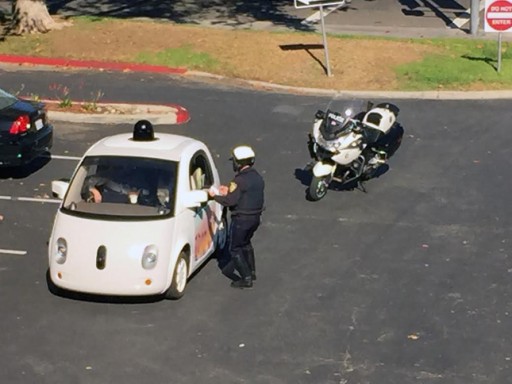And the challenge: self driving cars must learn to respond defensively to defective humans.
| Two (2) humans in self-driving car didn't move car out of faster lane |
 |
| But officer, the car can only drive 25 mph-- the zone limit is only 35 mpf |
When the officer made contact with the operators, he asked how they chose travel speeds and let them know the car was impeding traffic. Mountain View police said they regularly perform tests with Google to see how its cars react to emergency vehicles on the road.
Under the California Vehicle Code, the Google car is a neighborhood electric vehicle and cannot drive on roads with a speed limit above 35 mph. That meant the car was allowed to be on the road." Read article.
San Francisco Chronicle/SF Gate article (above) update, 11/15/15, "Police stop Google self-driving car for going too slowly." .... "The bubble-shaped prototype has two seats. Its top speed is 25 mph. "Driving
too slowly? Bet humans don't get pulled over for that too often,"
Google's self-driving car project wrote in a blog post. It said the cars
— outfitted with high-tech sensors and computing power — have never
received a ticket. .... Representatives of Google's self-driving car project have said that in
recent months they've been trying to program the vehicles to drive less
like robots and more like people — in part to reduce the number of times
they are hit by other drivers expecting certain driving behavior."
Related news articles. San Jose Mercury News/Peninsula/The Daily News/Jason Green, Staff Writer, 11/13/15, "Mountain View: Google self-driving car pulled over for 'driving too
slowly'." "MOUNTAIN VIEW -- When one of Google's self-driving vehicles is pulled over, who gets the ticket? The passenger or the car? ..... The vehicle didn't stop itself; a passenger took control and pulled over for the officer, according to police. ... So, no ticket, and the question of who would get it remains unanswered." New York Times/Business Day/Christine Hauser, 11/13/15. "Google driverless car is stopped by California police for going too slowly." “The
officer stopped the car and made contact with the operators to learn
more about how the car was choosing speeds along certain roadways and to
educate the operators about impeding traffic,” a police statement said. Under
the California Vehicle Code, the cars are permitted to operate on
streets that have a speed limit of 35 m.p.h. or slower, the police said. So
no ticket was issued. The car technically had no driver, but there are
usually two operators in the Google cars capable of taking over if
needed, and that was the case this time, the police official in charge
of the traffic team, Sgt. Saul Jaeger, said in a telephone interview. The
Google vehicle was allowed to go on its way, with the understanding
that if the operators noticed that traffic was stacking up, they needed
to pull over and let it flow by, just as if someone had engine trouble
and was inching down the road. “Just like anybody,” Sergeant Jaeger
said. Google’s autonomous test cars are programmed to follow the letter of the law. But as The New York Times reported in September,
researchers in the fledgling field of autonomous vehicles say that one
of the biggest challenges facing automated cars is blending them into a
world in which human drivers don’t behave by the book."
Note photographs. Google self-driving car on San Antonio Road, Mountain View, June, 2015 by Gordon De Los Santos/Google from New York Times. Policeman by Zandr Milewski from VIN News blog, also from Associated Press in the San Francisco Chronicle/SF Gate article update (above).
Posted by Kathy Meeh


No comments:
Post a Comment